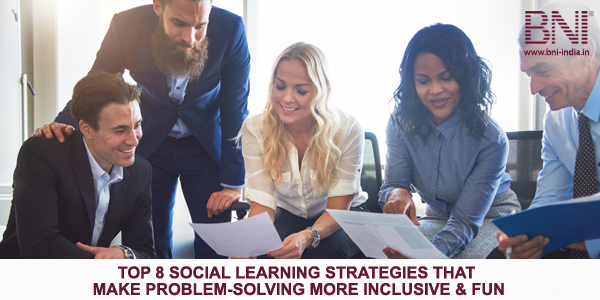461
Social learning is fast catching up as one of the best ways to train & solve as a team. Learning & development departments have begun to embrace various social learning tools that enhance employee productivity & make learning/training more a one-to-one interaction rather than a one-sided lecture.There is more scope for teamwork & collaborations with social learning strategies which brings everyone to a level playing field. There is no leader, everyone is a learner or sharer.
Here are some great social learning strategies you could use:
- Coaching/Mentorship/Tutoring: An expert & a learner interact on a one-on-one basis. This expert could be a subject matter expert, an experienced peer or a mentor. This one-2-one interaction can be a comforting way to learn and tutor. The learner can make the most of this private dialogue and ask questions freely, without any hesitation.
- Presentations: They may be old school, but presentations are a great way to self-learn & learn as a team. The learners themselves explore a particular topic and share their insights with others. Presentations also pave the way for Q & A session which has immense capacity to explore a topic comprehensively and extend the conversations to different dimensions.
- Collaborative Document Interaction: Learners come together to correct or improve one particular document/project. Update your learning management system with tools that allow more people to edit and provide suggestion on the same doc and at the same time to control the authenticity & accuracy of the final version to be submitted and allow for timely submission.
- Group Discussions: Group discussions are not only fun but also highly informative since they bring different minds to discuss and learn one particular topic. This is a great social learning tool for when you are introducing something new to all the learners, like a new product idea or a renewed work or office policy.
- Panel Discussion: A community or subject matter expert can talk about pressing issues and learners who attend these panels can gain great insight from personal experiences & learnings of the expert.
- Symposium Interaction: Unlike a panel discussion which has one expert talking about a particular issue, in a symposium interaction you have a group of experts who dialogue & debate about how to tackle certain problems/issues by giving a variety of potential solutions. One of the most cost-effective ways to get all of them on one platform is through a webinar.
- Peer groups/forums: Tools like video-conferencing enable great peer interactions. Colleagues could connect with each other to learn & share their experience regarding certain work aspects. Peer advisory groups are great platforms to share problems and brainstorm on the possible solutions.
- Social e Learning Tools: Real-time sharing & learning is instant, interactive & informative on many levels. Visual sharing platforms like video conferencing & wikis (collaborative document interactions) allow for sharing more data by linking information from different resources. File sharing, social bookmarking, whiteboards & application sharing all emulate collaborative human interaction patterns. Even social media & digital tools like tagging, creating mashups, keywords promote natural human interactive patterns on online platforms.
